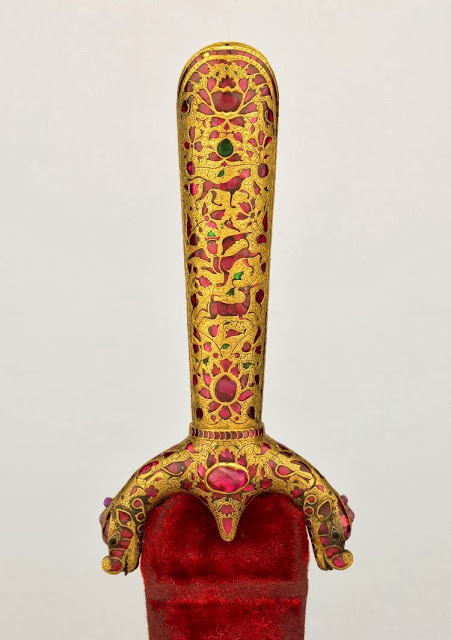Shiels (Dhal), Lucknow, first half 19th century. Silver gilt, brass, enamel and diamonds. Photo The Royal Collection Trust
On the photo above there is a shield presented to Albert Edward Prince of Wales by the Maharajah of Kashmir, Ranbir Singh Sahab Bhadur during his visit to India 1875-76. The front of the shield is made of silver gilt, decorated overall with champlevé enamels, mounted with four bosses and inset with seven tear-shaped ornaments and a crescent motif, all of them set with diamonds. The colours employed for the enamelling - numerous animals and birds, some of which are attacking one another - are characteristic of Lucknow work of the eighteenth and nineteenth centuries.
Shield India. 17th or 18th century. Rhinoceros hide, decorated with gold lacquer painting; steel protective knobs, enamelled and engraved. Diameter 43 cm. Museum of Oriental Arts, Moscow
Shield, West India (Gujarat?) c. 1575. Wicker, leather, velvet, steel with intarsia in gold and mother-of-pearl on black bituminous paste. Photo source
Scabbard (peshkabz). Steel, gold, emerald, rubies, pearls and cotton covered wood. The Royal Collection Trust
Shield, 18th century. Silver sheet, enamel, rubies, diamonds, emeralds, chalcedony, agate, rock crystal. The al-Sabah Collection
Katar with gold hilt and scabbard, set with rubies, emeralds, and diamonds. India; end of 18th century. The David Collection
This katar comes from Hyderabad, which was allied with the British against Tipu Sultan from Mysore. The dagger is said to have belonged to Tipu Sultan himself. The “Tiger from Mysore” was a formidable opponent of the British until he was killed in the defense of his capital of Seringapatam in 1799.
Dagger, 1625. Steel, ruby, gold, emerald. The British Museum
Dagger with incised gold sheath and chape set with rubies and emeralds, red velvet sides, notched gold hilt decorated with flowers, cheetah, harpy, and deer in rubies and emeralds on one side and three flowers, lion and deer on the other; quillon in form of two dragons' heads. Gold is worked between jewels in technique typical of court production in 1620's








No comments:
Post a Comment